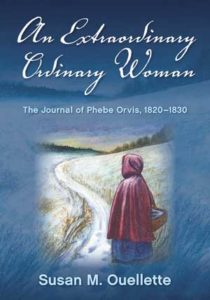An Extraordinary Ordinary Woman: The Journal of Phebe Orvis, 1820–1830
Reviewed by Neal Burdick
February 1, 2018
 By Susan M. Ouellette. State University of New York Press, 2017. 380 pages. $29.95/paperback; $29.95/eBook.
By Susan M. Ouellette. State University of New York Press, 2017. 380 pages. $29.95/paperback; $29.95/eBook.
For ten years, 1820 through 1830, and again briefly in the 1850s, Phebe Orvis maintained an almost daily journal. The 1820 through 1830 segment covers the years when Orvis, a young Quaker woman, entered adulthood, left the family and the meetings she had grown up among in central Vermont, and migrated to the comparatively roughshod frontier of northern New York’s St. Lawrence Valley. It was here that she “married out of meeting” (there not being a meeting in her new environment); fulfilled the traditional roles of a pioneer farm wife; raised 11 children; and, under duress, left Quakerism, at least outwardly.
Phebe’s diary was lost for more than a century, turning up at an estate auction in the 1960s. Fortunately, it eventually made its way into the hands of someone who recognized its value. Susan Ouelette is a professor of history and American studies at Saint Michael’s College in Vermont, and it is she who has brought Phebe’s diary to the public.
The diary constitutes the second half of the volume, reproduced nearly verbatim; to her credit, Ouelette edits only when absolutely necessary for comprehension. She devotes the first half of the book to several chapters that set the scene of Phebe’s writing and provide both historical and cultural context for it.
True to Quaker practice, Phebe wrote plainly and forthrightly. Almost daily comments on the weather are eloquent in their simplicity: “Pleasant” or (frequently, given the wintry climate into which she moved) “Some snow.” She also spoke her mind: “Oh how blind are those who won’t see and how deaf are those that won’t hear, and to what length will prejudice carry a person.”
Phebe migrated to live with relatives, marrying only after she’d settled into her new environment. Her marriage sorely tested her Quaker faith: her husband, Samuel Eastman, came under the influence of the Second Great Awakening, and relentlessly berated Phebe for not having been baptized in the traditional Protestant manner. She finally gave in to his pressure and, in order to keep peace in the family, was baptized and joined the local Baptist Church, where she was considered a member in good standing for the rest of her life. (She died in 1868 at age 67.)
The language and tone of her journal, though, reveal that she never surrendered her Quaker beliefs and principles. For instance, she remained sympathetic to the cause of abolition, noting in the latter segment of her journal—long after she had officially become a Baptist—that while traveling she attended meeting with the Keese/Smith family at the Quaker Union near Peru, New York, where there had been collaboration in the Underground Railroad. Some of the Keese/Smith family members were agents in the movement (and coincidentally, my direct ancestors).
Phebe’s journal recounts a difficult life: endless farm and family chores, from butter-churning to sewing; continual pregnancies; loneliness; fatigue; one child’s death. Why she stopped keeping her journal in 1830, before returning to it briefly 25 years later, she does not say. Ouelette speculates, reasonably, that the burdens of a growing family, work, and advancing years may have taken their toll on her time and energy.
Ouelette does a good job of letting Phebe tell her own story in her own voice. The explanatory chapters fill out her history without intruding upon it. My one objection to her narrative is that she refers throughout to the diarist and her husband as “Orvis” and “Eastman,” not “Phebe” and “Samuel.” This may be in keeping with scholarly custom, but not only does it violate the marriage codes of the time, it also dehumanizes the pair.
That complaint aside, contemporary Quakers will find the book interesting, perhaps even compelling, as it shows us the life of an early nineteenth-century Quaker teenage girl who leaves her familiar surroundings, marries and starts a family, works her fingers to the bone on a frontier farm, and is worn down by challenges to the religion of her upbringing. Perhaps we don’t relocate to such harsh conditions today, but how many among us can still relate to Phebe, her physical and spiritual travails, and her faith?
Correction: the print version of this incorrectly stated that the reviewer was a descendant of Phebe Orvis; it has been corrected here that he descends from the Keese/Smith family.



Comments on Friendsjournal.org may be used in the Forum of the print magazine and may be edited for length and clarity.